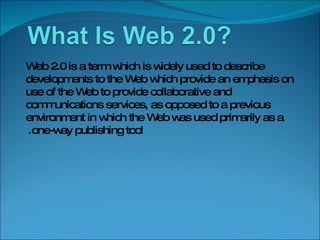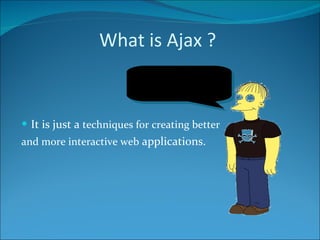Web2 And Ajax
- 1. Web 2.0 is a term which is widely used to describe developments to the Web which provide an emphasis on use of the Web to provide collaborative and communications services, as opposed to a previous environment in which the Web was used primarily as a one-way publishing tool.
- 2. The main technologies which are identified with the term °ÆWeb 2.0°Ø are: Blogs: Typically Web pages provided in date order, with the most recent entry being displayed first. Blog tools produce RSS, which allows the content to be read via a variety of tools and devices . Wikis: Simple collaborative Web-based authoring tools, which allow content to be created and maintained by groups without needing to master HTML or complex HTML authoring tools.
- 3. RSS : RSS (Really Simple Syndication) allows content to be automatically integrated in other Web sites or viewed in applications, such as RSS readers. A key feature of RSS readers is the automatic alerts for new content. Podcasts: Podcasts are a type of RSS, in which the content which is syndicated is an audio file. New podcasts can be automatically embedded on portable MP3 players . AJAX: The user interface of many Web 2.0 applications is based on a technology called AJAX, which can provide easier to use and more intuitive and responsive interfaces than could be deployed previously .
- 4. Network as platform : Rather than having to install software locally, Web 2.0 services allow applications to be hosted on the network. Always beta: Since Web 2.0 services are available on the network, they can be continually updated to enhance their usability and functionality. Culture of openness: A key benefit of Web 2.0 is provided by allowing others to reuse your content and you to make use of others°Ø content. Creative Commons licences allow copyright owners to permit such reuse. This has particular benefits in the cultural heritage sector. Tagging: Rather than having to rely on use of formal classification systems (which may not be meaningful to many users) tags can be created by users. The tags, which may also be meaningful to their peers, provide communal ways of accessing Web resources.
- 5. What is Ajax ? It is just a techniques for creating better and more interactive web applications. AJAX is not a programming language.
- 6. What is Ajax ? Cont°≠ Ajax (shorthand for asynchronous JavaScript and XML) Ajax is a group of interrelated web development techniques used on the client-side to create interactive web applications. Ajax isn°Øt a technology. It°Øs really several technologies, each flourishing in its own right, coming together in powerful new ways
- 7. Web application model: The traditional model for web applications (left) compared to the Ajax model (right).
- 8. How Ajax is Different? An Ajax application eliminates the start-stop-start-stop nature of interaction on the Web by introducing an intermediary °™ an Ajax engine °™ between the user and the server. This engine is responsible for both rendering the interface the user sees and communicating with the server on the user°Øs behalf . The Ajax engine allows the user°Øs interaction with the application to happen asynchronously °™ independent of communication with the server. So the user is never staring at a blank browser window and an hourglass icon, waiting around for the server to do something.
- 9. XMLHttpRequest The XMLHttpRequest object has 2 important methods: The open() method The send() method
- 10. Cont°≠ The open() method takes three arguments : The first argument defines which method to use (GET or POST). The second argument specifies the name of the server resource . The third argument specifies if the request should be handled asynchronously. The send() method sends the request off to the server.
- 11. Important Properties The XMLHttpRequest object has 3 important properties: The responseText property The readyState property The onreadystatechange property
- 12. Who°Øs Using Ajax Google Groups . Google Suggest. Google Maps.











